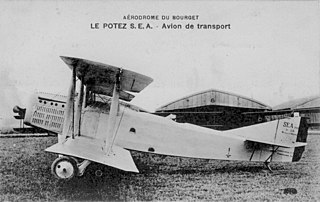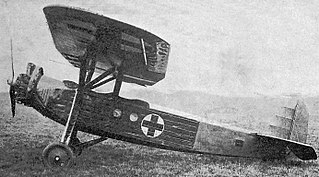
The Bloch MB.130 and its derivatives were a series of French monoplane reconnaissance-bombers developed during the 1930s. They saw some limited action at the beginning of World War II but were obsolete by that time and suffered badly against the Luftwaffe. After the fall of France, a few were pressed into Luftwaffe service.

The SEA IV was a French two-seat military aircraft of World War I and the immediate post-war era.

The Bloch MB.210 and MB.211 were the successors of the French Bloch MB.200 bomber developed by Société des Avions Marcel Bloch in the 1930s and differed primarily in being low wing monoplanes rather than high wing monoplanes.

Hanriot H.230 was a French twin-engined advanced trainer. The construction of the aircraft was initiated in 1936 by Hanriot's chief designer Montlaur. The aircraft was produced by the nationalized factory SNCAC.

The Blériot-SPAD S.61 was a French fighter aircraft developed in 1923. Designed by André Herbemont, the S.61 was a conventional biplane, abandoning the swept upper wing used by Herbemont in several previous designs. The prototype S.61 was evaluated by the French Air Force alongside the S.51 as a potential new fighter, but like its stablemate, was rejected. The Polish Air Force was impressed enough to order 250, as well as purchase licences for local production. The Romanian Air Force also ordered 100 aircraft. About 30 were built in Poland, by the CWL.

The Farman F.120 and its derivatives were a family of multi-engine airliners and bombers of the 1920s built by the Farman Aviation Works in France.

The Morane-Saulnier MS.230 aircraft was the main elementary trainer for the French Armée de l'Air throughout the 1930s. Almost all French pilots flying for the Armée de l'Air at the outbreak of World War II had had their earliest flight training in this machine. It was the equivalent of the Stearman trainer in the United States air services and the de Havilland Tiger Moth in the British Royal Air Force.

The Hanriot HD.14 was a military trainer aircraft produced in large numbers in France during the 1920s. It was a conventional, two-bay biplane with unstaggered wings of equal span. The pilot and instructor sat in tandem, open cockpits, and the fuselage was braced to the lower wing with short struts. The main units of the fixed tailskid undercarriage were divided, each unit carrying two wheels, and early production examples also had anti-noseover skids projecting forwards as well.
The Hanriot HD.17 was a French trainer seaplane of the 1920s. It was essentially a floatplane version of the ubiquitous HD.14 with a revised tail and a more powerful engine. Over 50 examples were operated by the Aéronautique Maritime, of which seven were converted to landplanes. A small number of HD.17s were exported to Estonia and Latvia. Further development resulted in the HD.41H.

The Hanriot H.41 was a military trainer aircraft produced in France in the 1920s. It was a further development in the family of aircraft that had commenced with the HD.14 in 1920, and incorporated a number of design features that had been developed for other members of that family. Like those other aircraft, however, it was a conventional, two-bay biplane with unstaggered wings of equal span.

The Lorraine-Hanriot LH.10 was a family of training monoplanes built in France in the early 1930s, the most widely produced and well-known member of which was the LH.16, later known simply as the Hanriot H.16. It was a conventional parasol-wing monoplane with fixed tailskid undercarriage, the main units of which were mounted on outriggers attached to the wing struts. The pilot and instructor sat in tandem open cockpits.

The Hanriot H.43 was a military utility aircraft produced in France in the late 1920s and early 1930s which was primarily used by the Aéronautique Militaire as a trainer. While Hanriot had spent most of the 1920s manufacturing further and further developments of the HD.14 that had flown in 1920, the H.43 was an entirely new design. It was a conventional single-bay biplane with staggered wings of unequal span and a fuselage of fabric-covered metal tube. Accommodation for the pilot and passenger was in tandem, open cockpits and the main units of the fixed, tailskid undercarriage were linked by a cross-axle.

The Letord Let.5 was probably the most numerous of a family of 3-seat reconnaissance bombers, designed and built in France from 1916, originally to an A3 specification from the STAé.

The Farman NC.470 was a French twin-engined floatplane designed as a crew trainer for the French Navy. It was used in small numbers for both its intended role as a trainer and as a coastal reconnaissance aircraft at the start of World War II.

The Morane-Saulnier MS.129 and its derivatives in the MS.130 series were a family of military trainer aircraft produced in France in the 1920s. They were conventional, parasol-wing monoplanes with open cockpits in tandem and fixed tailskid undercarriage. The initial version, the MS.129, was produced in small numbers for the Romanian Air Force and civil users, but the major production version was the MS.130, which equipped the French Navy and a number of foreign air arms.

The SAB AB-20 was a large four engine twin boom French bomber built in the early 1930s as a development of the Dyle et Bacalan DB-70 airliner. It featured a lifting body of thick airfoil section between the inner engines. It was later modified for the attack role; a second aircraft, the AB-21, had different engines and cleaner aerodynamics but no more were built.

The Les Mureaux 3 C.2 and Les Mureaux 4 C.2 were French two seat, parasol winged fighters, flown in 1927-8, which differed only in their engines. They were developed into near identical army co-operation types, the ANF Les Mureaux 130 A.2 and ANF Les Mureaux 131 A.2, in 1929-31.

The Lorraine Hanriot LH.41 was a single-seat racing aircraft designed and built in France specifically to compete in the Coupe Michelin air races, held in France.

The Lorraine-Hanriot LH.21S was designed and built in 1930 to meet a French government requirement for a small air ambulance capable of operating in the colonies. It did not reach production.
The Lorraine-Hanriot LH.30 was a training monoplanes built in France in the early 1930s.



















